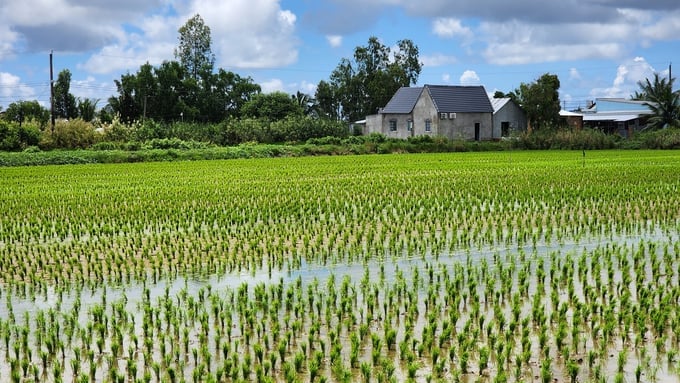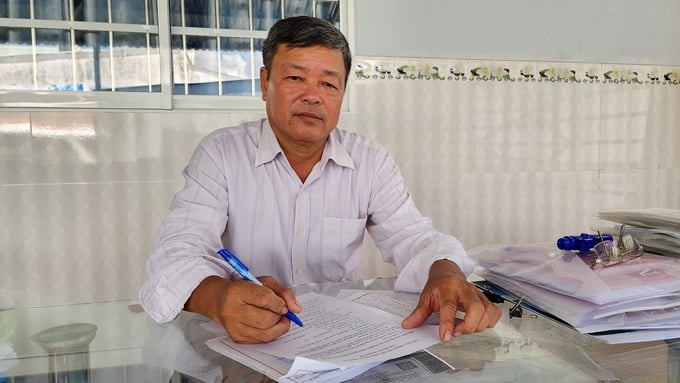May 25, 2025 | 07:59 GMT +7
May 25, 2025 | 07:59 GMT +7
Hotline: 0913.378.918
May 25, 2025 | 07:59 GMT +7
Hotline: 0913.378.918
We visited Dong Thanh commune, An Minh district, Kien Giang province in October to learn about the organic shrimp-rice model which is being diligently developed by local farmers. Along the Xuyen A route in An Minh district, rice fields have been transformed by farmers to facilitate both rice and shrimp production.

One-month-old organic rice field in Dong Thanh commune, An Minh district, Kien Giang province. Photo: Kim Anh.
Farmer Pham Van Hoang Dieu, one of the pioneering faces in organic rice production in Dong Thanh commune, led us to visit his one-month-old organic rice field. Commenting on the local history of rice production, Mr. Dieu explained that the local soil was previously contaminated with salinity, and farmers primarily grew seasonal rice, producing only one crop per year with limited yield. Each crop of rice requires at least six to seven months to fully grow before harvesting. As a result, local farmers focused on growing rice as food for family consumption instead of an economic endeavor.
Thanks to support from An Minh district's Department of Agriculture and Rural Development since 2016, farmers in the commune began deploying the organic shrimp-rice production model. However, with exensive experiences in traditional farming practices, Mr. Dieu and many local farmers hesitated to participate in large scale production due to concerns regarding low rice yields.
"After following the organic production model, we realized that the model is much easier compared to traditional methods. In the past, we used large volumes of chemical fertilizers and pesticides without consideration. After switching to the organic production model, the shrimp waste in the fields serves as an excellent fertilizer for the growth of rice plants, so farmers no longer have to rely on chemical fertilizers and pesticides," shared Mr. Dieu, drawing significant lessons from participating in the organic shrimp-rice production model.
After observing initial positive results from the model, Mr. Dieu converted 5 hectares of his family's production area to an organic model in 2019.
The majority of local farmers in Dong Thanh commune are currently participating in the organic shrimp-rice production model. Between January and March of 2023, these farmers have renovated shrimp ponds, stocked shrimp larvae, and began harvest in July. In addition, farmers within this model also combine the production of crabs and giant freshwater prawn to increase additional income on the same production area. Subsequently, farmers proceed to desalinate the shrimp ponds in August and replant rice in September.

Farmer Pham Van Hoang Dieu calculates that the shrimp-rice model brings his family an annual profit of approximately 180 to 200 million Vietnamese dong per hectare, including income from white-leg shrimp, organic rice, and other aquatic species. Photo: Kim Anh.
The organic shrimp-rice production model possesses the advantages of cutting input costs, producing off-season rice with high market prices and stable outlets. After nearly four years participating in the development of this model, the livelihoods of Mr. Dieu's family, as well as many families in the region, have improved significantly, providing better conditions for their children's education.
According to Mr. Dieu, combining the production of shrimp and rice is highly sustainable. Namely, shrimp farming reduces feed costs, and in return, rice farming requires a lower volume of fertilizer and prevents the use of pesticides, thereby creating an environment that benefits shrimp growth. This farming model is both environmentally friendly and protects the health of producers and consumers, motivating local farmers to actively pursue the initiative.
According to Mr. Dieu's calculations, farmers can achieve an annual profit of approximately 180 to 200 million Vietnamese dong from the production of white-leg shrimp, organic rice, and other aquatic species on a 1-hectare area. Thanks to close production linkage with businesses, the products are easily marketed, and farmers are less dependent on traders who may manipulate prices.
There are currently over 47,000 hectares dedicated to aquaculture in An Minh district, including 39,000 hectares of shrimp-rice production area, and over 25,000 hectares of repeat rice crop area.
Established in 2016 with 13 members and a production area of less than 20 hectares, the Thanh An Shrimp-Crab-Rice Cooperative (located in Dong Thanh commune, An Minh district) initially adhered to traditional farming practices. At the time of its establishment, cooperative members failed to coordinate their activities, and there was no uniform approach to shrimp releasing or rice sowing. Furthermore, the cooperative had not established partnerships with businesses for product marketing, with each member working independently.

Thanh An Shrimp-Crab-Rice Cooperative supplies approximately 1,100 tons of organic rice to businesses on an yearly average. Photo: Kim Anh.
The cooperative has encouraged its members to adopt the shrimp-rice farming model in addition to signing agreements with businesses to produce organic rice for export. This milestone marks a new development in the lives and production of the cooperative members.
In 2019, the number of cooperative members increased to 25, covering an area of 50 hectares. To date, the cooperative has reached 61 members, with a production scale of 300 hectares. All of the cooperative members follow the shrimp-rice organic farming model, and their entire output is purchased by the Dai Duong Xanh Company, with the primary focus being the ST5 rice variety.
ST25 rice variety has a growth period of 120 days, which is suitable for the farming conditions of the shrimp-rice production area. Mr. Nguyen Van Khanh, Director of the Thanh An Shrimp-Crab-Rice Cooperative, mentioned that organic rice cultivation yields are comparable to traditional chemical fertilizer methods, with an average of about 4.9 tons per hectare.
In addition, members of the cooperative also receive support from the business in terms of providing rice seeds, fertilizers, and guidance on organic rice cultivation processes. At the beginning of each crop season, the cooperative and the business sign contracts to guarantee the purchase of organic rice at a fixed price, set at 7,000 VND/kg for the year 2023.
According to the Thanh An Shrimp-Crab-Rice Cooperative, the cooperative supplied 1,100 tons of organic rice to businesses on an area of 350 hectares in 2022. Subsequently, the cooperative expanded to nearly 400 hectares of organic rice production area in 2023.
Mr. Khanh acknowledged that farmers were initially skeptical about organic rice production due to their prior focus on shrimp farming, which brings high income due to the shrimp's high market value. Additionally, the An Minh region's unique conditions, with only one rice crop per year, presented challenges due to a lack of investment in infrastructure or drying facilities from businesses. Harvesting during the rainy season also resulted in unmarketable rice products. The majority of local farmers only produced enough rice to meet their family's needs, utilizing 40% to 50% of their total production area.

Mr. Nguyen Van Khanh, Director of the Thanh An Shrimp-Crab-Rice Cooperative, expressed optimism in the shift towards the shrimp-rice farming model, which has significantly improved the lives of cooperative members. Photo: Kim Anh.
After establishing a partnership with Dai Duong Xanh Company, the local organic rice production model on shrimp fields has been significantly expanded. Local farmers enjoy an average annual profit of 24 to 25 million Vietnamese dong per hectare. Notably, skilled farmers who work diligently, closely monitor and nurture their fields can achieve profits exceeding 30 million Vietnamese dong per hectare.
Mr. Khanh is particularly optimistic about the future of the organic rice market. Accordingly, he plans to expand the scale of local shrimp-rice production to at least 1,000 hectare. Consequently, this effort provide a stable supply of organic rice raw materials for businesses in accordance with the local manual harvesting conditions.
"Despite manual rice harvesting, farmers are motivated because they can also collect shrimp, crabs, and fish in the fields, ensuring additional income. Dai Duong Xanh Company has the capacity for transportation, drying, and post-harvest services, so they can purchase manually-harvested rice at high prices," expressed Mr. Khanh.
Moreover, due to the recent increase in rice prices, the cooperative and the company have carefully calculated and balanced interests before signing the first crop consumption contracts, with specific agreements such as fixed prices. Accordingly, when the market price increases, both parties will share the additional profit equally. On the other hand, if rice price decreases, the company still commits to purchasing at the agreed fixed price as stated in the signed contract.
In addition to producing organic rice for export-oriented businesses, Thanh An Shrimp-Crab-Rice Cooperative has established the ST25 Thanh An Rice brand since August 2022, achieving a 3-star OCOP rating. Furthermore, the cooperative has partnered with Minh Phu Seafood Corporation to implement advanced shrimp production processes, with the aim of meeting organic standards to enhance the value of the shrimp.
The Ministry of Agriculture and Rural Development issued Decision No. 1088/QD-BNN-KTHT dated March 25, 2022 approving the pilot project to establish standardized agricultural and forestry material areas for domestic consumption and export from 2022 to 2025. The project is being implemented in 46 districts and cities across the 13 provinces of Hoa Binh, Son La, Quang Tri, Thua Thien - Hue, Gia Lai, Dak Lak, Dak Nong, Kon Tum, Dong Thap, Long An, Tien Giang, Kien Giang, and An Giang.
The project is divided into two phases: Phase 1 from 2022 to 2023 and Phase 2 from 2024 to 2025. During Phase 2, the construction of five preliminary processing, processing, and raw material storage centers will be expanded to support cooperatives. These facilities include: a logistics center for the rice production chain in Thoai Son district, An Giang province; a logistics center for organic rice and shrimp production in An Minh district, Kien Giang province; a logistics center for shrimp processing in Cu Lao Dung district, Soc Trang province; My Hiep logistics center for fruit in Dong Thap province; and a logistics center for the coffee chain in Gia Lai province.
Translated by Nguyen Hai Long

(VAN) The People's Committee of Tra Vinh province has approved an adjustment to the investment policy for the Green Hydrogen Plant project, increasing its area to approximately 52.76 hectares.
![Reducing emissions from rice fields: [2] Farmers’ commitment to the soil](https://t.ex-cdn.com/nongnghiepmoitruong.vn/608w/files/news/2025/05/05/dsc08881jpg-nongnghiep-140632.jpg)
(VAN) Clean rice cultivation model in Thuong Tan commune, Bac Tan Uyen district, is assisting local residents in achieving sustainable agriculture by substantially reducing costs, increasing productivity, and protecting the environment.

(VAN) At the conference to disseminate Resolution No. 68, AgriS introduced its digital agricultural ecosystem and reaffirmed its commitment to accompanying the Government in promoting private sector development and sustainable agriculture.

(VAN) 'Blue Ocean - Blue Foods' initiative is designed to restore marine ecosystems and establish sustainable livelihoods for local communities by cultivating a minimum of 1,000 hectares of cottonii seaweed in the first three years.
/2025/05/21/4642-3-112707_603.jpg)
(VAN) The V-SCOPE project has made direct contributions to three out of six pillars of the Comprehensive Strategic Partnership between Vietnam and Australia.

(VAN) Facing the threat of rabies spreading to the community, Gia Lai province urgently carries out measures to vaccinate dogs and cats on a large scale.

(VAN) Disease-free livestock farming not only protects livestock herds but also stabilizes production and livelihoods for many farmers in Tuyen Quang.